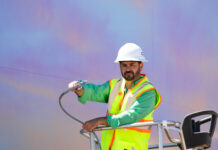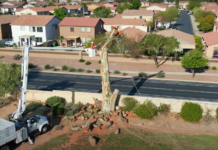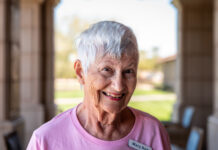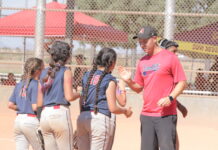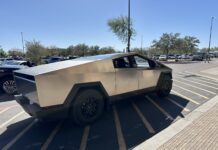Maricopa at the Wells in the 1800s was a busy and lively environment, and it was a major hub as a railroad junction and center of activity in the late 1800s and early 1900s. However, during its early farming days, in the 1940-50s, it had limited and rough dirt roads, 25-cycle electricity, few businesses, no high school, no churches, no doctors and few phones.
The following story is from Maricopa Historical Society’s Written History Project files. Eloise Hadley Chance depicts a young mother’s life and experiences dealing with everyday difficulties living in the rural and isolated farming community of Maricopa in the early 1950s.
“My parents were farmers/ranchers living southeast of Chandler, Arizona, so I was accustomed to farm life, but nothing prepared me for the life I encountered when Charles and I moved and established residence in the Maricopa area in March 1952.
“Charles and I were living in Tucson and enjoyed all the conveniences and social activities of city life. My father called us and said he had purchased a section of land in the Maricopa area of Pinal County. He wanted us to move on his farm and manage it.
“Since my husband had also grown up on a farm in east Texas, he was eager for the opportunity. I reluctantly agreed. I had never been to Maricopa nor had even heard of it before, so it was with extreme disbelief when I was exposed to the place I would be living for the next 24 and ½ years.
“To complicate matters, I was six months pregnant. My Tucson doctor referred me to a Dr. Phillip F. Hartman in Mesa, Arizona. Dr. Hartman delivered our first child, a daughter, Carol, in June 1952.
“A coincidence was the fact we lived on Hartman Road named after the same Dr. Hartman who delivered Carol and who owned land in the area and was the father of current resident, McD Hartman.
“I feel that we actually pioneered the Maricopa area. We did have electricity even though it was 25 cycle electrical appliances.
“Perhaps the most difficult adjustment facing us was the lack of people to socialize with. We had no really close neighbors, but we became acquainted with those living nearest to us—the Sy Whilhoits to the east, the Grant Tows to the north, the Jack and Claude Crains to the south. We arranged to have occasional get-to-gathers, and that was most therapeutic.
“There was one pay phone at Maricopa Growers Gin located just a few miles from us, but there was no direct road connecting us. To reach the gin, we had to drive through the Anderson-Palmisano Farm to Murphy Road, then south to Maricopa-Casa Grande Road (then a dirt road) west to Hartman Road (the gin location). Following the Maricopa-Casa Grande Road west would take us into Maricopa—if the wash was not running. In those days, there was no bridge over the wash.
“Every summer afternoon without fail, we would literally be bombarded by thick dust storms that left behind a house full of dirt. The dust storms were accompanied by fierce electrical storms whose rain sometimes inundated us for days since the trail-type roads would become flooded and not suitable for travel. I remember the night lightning struck our large haystack and completely destroyed it.
“We had special invitations to witness the lightning’s heavenly antics as the storm’s display created a spectacular show unparalleled by our Fourth of July celebrations, and the thunder roared and was most foreboding. This was usually an every evening occurrence.
“I really suffered after the birth of our baby. Much of it was of my own making. Living so far away from everyone and not having phone accessibility, I worried every time she sneezed or cried. I was unable to have assurance or counsel from anybody that the symptoms I was concerned about were actually normal. As a result, I made many harrowing trips to her doctor in Chandler. We were forced to make our own roads and detours after the rain since washed out roads or ruts would be scary to try to navigate. To get to Chandler, I would travel through neighboring farms onto part of the Gila River Indian Community and finally to the Casa Blanca Road which took us to the highway north to Chandler.
“The doctor would examine her and state she was fine and healthy. This reassurance would last a couple of weeks until I would become alarmed as more symptoms appeared. The patient doctor finally told me I just needed to have another baby so I would have less time being worried and concerned about Carol. His prophetic words were put into motion and our second baby girl, Cathleen, was born in December, 1953.
“In those days, I was an ardent follower of Dr. Spock, and I had almost memorized his book. That was also part of my problem. Interestingly enough, in future years, his book was practically banned as not being a trusted medical authority. Fortunately, no real crisis presented itself.
“Life was hard at best. While I was trying to adjust to a totally foreign way of life in a likewise foreign area, Charles, too, was consumed with work-related problems of major proportion. The farm had no cement ditches, and the dirt ditches would overflow and wash out sections of the ditches and then flood the immediate area and would require much physical shoveling to repair.
“The electricity would go off during storms, and when the power would come on, it required all of the different heads of water to be started again. There were hundreds of irrigation pipes to start. There were times when the workers did not show up, and then problems were magnified and presented many distresses.
“There were many snakes and scorpions to contend with, and the environment was also inhabited by packs of coyotes.
“We attended Calvary Baptist Church in Casa Grande. The pastor there introduced us to another Maricopa couple, Herschel and Doris Kenmore and their three children. The pastor and Calvary Church were interested in sponsoring a church mission in Maricopa. So, the Kenmore and Chance families held Sunday School classes beneath a mesquite tree directly across the street from the elementary school for a few weeks.
“Mr. John Evans, principal, contacted us and allowed us to hold classes in the elementary school facilities. Eventually, the classes grew, and the First Baptist Church of Maricopa was started with the generous financial help of farmers in the area who gave the proceeds from a designated number of bales (of cotton) contributed for that purpose.
“Dr. Lowell Berry was a major contributor, and Mr. and Mrs. C.P. Honeycutt gave land for the church building. By this time (1955), many families had moved into the Maricopa area. Families would get together and have potluck dinners, etc.
“As more people moved into the Maricopa area over the years, the residents experienced camaraderie as well. People really cared about each other in an almost family way, and always lent a helping hand to those experiencing difficulties of whatever nature.
“Maricopa was truly good to us. One cannot measure the worth of rearing children in a community of like-minded neighbors whose intrinsic values developed and became a way of life with our young people.
‘We were blessed with five children, Carol Ann, Susan Cathleen, Cynthia, Richard and Michael during our Maricopa residence. Michael continues to live in the Maricopa area today. However, we moved to Casa Grande in 1976. We continue to have fond memories of our tenure in Maricopa, and its blessings far out-measure any hardships we endured.
“So, with progress comes change, and we again have to adapt to new ways of life. Maricopa has changed so much with all of the new developments. It saddens me when I look out for miles and see the once beautiful and fertile farmland now growing homes and businesses instead of the formerly grown food and fiber so necessary for our survival.
‘On the other hand, Maricopa can now boost its resident doctors, dentists, drug stores, shopping centers, restaurants and other service type businesses, which make for needed conveniences, and, for the most part, were totally nonexistent in the old Maricopa.
‘Members of my family and I enjoy attending occasional get-togethers and functions with a too fast decreasing number of old timers in the community, enjoying reminiscing about the “good old days.” We love you Maricopa, and looking with wonderment of what possibilities lay ahead in your continued history.”
Submitted photo
Maricopa Historical Society cordially invites all of Maricopa’s citizens to write, or give a video-taped interview of their stories, impressions and memories of coming to Maricopa whether it was ninety years ago or yesterday for future generations. For more information email Patricia Brock: [email protected]
Editor’s note: Maricopa factoids are a regular feature on InMaricopa.com. They are provided by the Maricopa Historical Society, a branch of the Friends of the Maricopa Public Library. Most information comes from “Reflections of a Desert Town” by author and historical society chairperson Patricia Brock.
Gift Cards are available for Brock’s the new book: “Images of America: Maricopa” along with a short story of Maricopa. Contact Brock at 480-821-0604 or [email protected] to purchase a gift card or to reserve a copy of the book.




